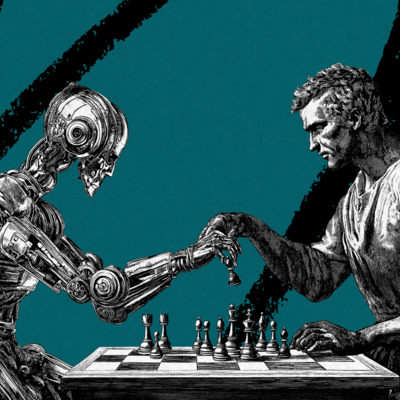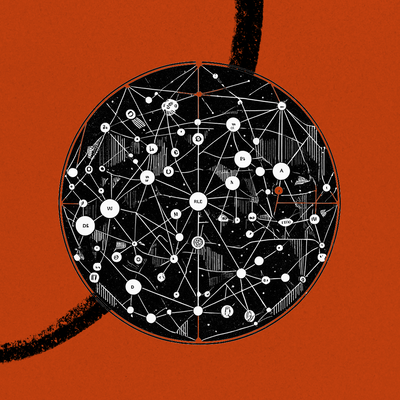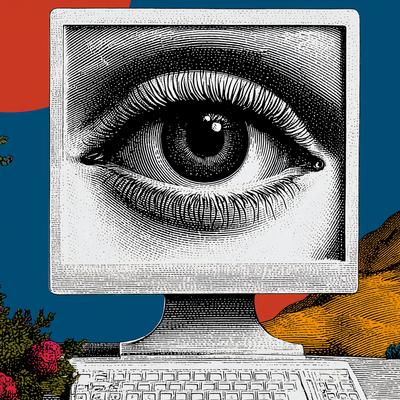
Technology changes how we see the world—and ourselves. If we want to save our conception of human creativity and intellect, we need to get clear on what LLMs can do and what humans are uniquely capable of. That’s what I’m attempting to do with this piece from the archives. If you’re interested, you can also watch it as a newly created video essay on YouTube, Spotify, or Apple Podcasts. —Dan Shipper
I remember when I first saw GPT-3 output writing: that line of letters hammered out one by one, rolling horizontally across the screen in its distinctive staccato. It struck both wonder and terror into my heart.
I felt ecstatic that computers could finally talk back to me. But I also felt a heavy sense of dread. I’m a writer—what would happen to me?
We’ve all had this experience with AI over the last year and a half. It is an emotional rollercoaster. It feels like it threatens our conception of ourselves.
We’ve long defined the difference between humans and animals by our ability to think. Aristotle wrote: “The life of the intellect is the best and pleasantest for man, for the intellect more than anything else is man; therefore, a life guided by intellect is the best for man.”
Two thousand years later, the playwright and short story author Anton Chekhov agreed in his novella, Ward No. 6: “Intellect draws a sharp line between the animals and man, [and] suggests the divinity of the latter.”
The primacy of thinking and the intellect as the feature by which we define ourselves has become even more salient as we’ve moved from an economy driven by industrial labor into one driven by knowledge. Indeed, if you’re reading this, you probably put a lot of stock into what you know. After all, that’s what knowledge work is all about. If we define ourselves and our value this way, it’s no wonder LLMs seem scary.
If AI can now write, and, worse, think, what’s left that makes humans unique?
I think LLMs will change knowledge work. In doing so, they’ll change how we think of ourselves, and which characteristics we deem uniquely human. But these days I’m not particularly scared. In fact, I’m mostly filled with excitement.
My sense of self has changed—and that’s a good thing. ChatGPT has made me see my intellect and role in the creative process differently than I did before. It doesn’t replace me; it just changes what I do. It’s possible to achieve this feeling of excitement by 1) getting a clearer conception of what LLMs actually do and don’t do, and 2) expanding your view of what you are and what you are capable of.
Let’s talk about what that looks like. To start, we have to understand what the intellect is.
What is the intellect?
For the purposes of this article, the intellect is the thing that humans uniquely have that animals don’t. This is a fuzzy definition, by design. It reflects what feels threatened by AI: that which makes us human.
In reality, the intellect is a gigantic combination of brain processes that look like thinking. Thinking, the intellect, the mind—these are all different processes that we lump under a single heading. That’s why it’s easier to define it via negativa, by what it is not—it’s whatever animals don’t do. (We now know that animals do have thinking processes that look a lot like what we might call intellect, but that hasn’t filtered into our popular conceptions of self. Read Frans de Waal’s classic book, Are We Smart Enough to Know How Smart Animals Are?, for an excellent overview of animal intelligence.)
Our fuzzy definition of the intellect is why our first encounter with ChatGPT and its ilk can be so terrifying. It touches a lightning rod within us. For millennia we’ve set ourselves apart by a strange, amorphous, many-dimensional thing called intelligence—and suddenly there is something encroaching on our turf. Because it can do some of the things we associate with the intellect, we feel both excited, because we’re no longer alone, and threatened—because we might be replaceable.
In order to regain our sense of self and place in the world, we need to redefine what we mean by “intellect.” We need to create a new sense of separation between what humans do and what AI can do. We need to redefine “intellect” so as to make it work in an AI-driven world.
Fortunately, we’ve done this before, and technology can help.
Psychology is a branch of science that is full of concepts that are fuzzy in the same way the “intellect” is. Take schizophrenia and bi-polar disorder. Neither is detected by a blood test, or even has a consistent set of symptoms. Instead, they’re characterized as syndromes: a set of often associated symptoms that can vary from case to case.
The problem is that there are significant overlaps between schizophrenia and bipolar disorder that can both cause psychosis and hallucinations. As late as the 1960s, schizophrenia and bipolar disorder were lumped together under a single heading and understood to have a similar underlying cause. But it turns out that technology—specifically, the discovery of the drug lithium—was the key ingredient that we needed to pull them apart.
It all started with guinea pigs.
Pharmacological dissection of mental illness
In the late 1940s, a doctor named J.F. Cade, who apparently had entirely too much time on his hands, discovered that the urine of manic patients was toxic to guinea pigs. (I can’t believe I just typed that sentence, but, like, we all have our kinks, I guess.)
Do not let this man around your guinea pigs. Source: Wikipedia.Anyway, Cade set out to find out why. He discovered that manic patients had elevated levels of uric acid in their pee and thought that might be what was causing the toxicity. He decided to perform a controlled experiment on the guinea pigs: He would inject them with varying levels of uric acid to see if increasing levels would cause toxicity.
To do the injections, he dissolved the uric acid into a lithium carbonate solution. When he injected the guinea pigs with lithium he noticed that they became remarkably calm. They just sat around in their cages and didn’t respond to being messed around with—a side effect he had not anticipated.
Then, in a move that revolutionized the field of psychology, Cade decided to inject the lithium carbonate into his manic patients. The results were astonishing: Lithium resolved their mania.
This is a remarkable series of events for two reasons: One, it resulted in a drug, lithium, that has saved many thousands of lives over the decades since it was discovered. And two, it acted as what the psychiatrist Peter Kramer calls a “pharmacological dissection” that differentiated manic depression as a separate disease from schizophrenia, with its own biological cause.
Kramer argued that manic depression hadn’t previously been thought of as separate from schizophrenia. Indeed, psychoanalytic thought, which was the prevailing model of the mind at the time, viewed all psychiatric issues as essentially about internal psychological conflicts resulting from childhood trauma.
But a drug, lithium—which cured manic depression, and only manic depression—helped carve the disease out as distinct from the rest of mental illness, and one that was fundamentally biological in origin. In other words, lithium was a lever that became a new lens on the way our minds work.
We can use this model to do a similar technological dissection on our intellect. Once we understand what ChatGPT does, it can help us further define and flesh out our previously fuzzy concepts like the intellect—while leaving our sense of what keeps us different intact.
ChatGPT is a summarizer
Technically, ChatGPT does next-token prediction. Given a string of words, it is very good at statistically predicting the most likely words that come next in the sequence.
In practice, that means that ChatGPT and other LLMs are incredible at reformatting, reconstituting, and recombining old knowledge in new and useful ways. The cognitive scientist Alison Gopnik and colleagues refer to LLMs as technologies that enhance “cultural transmission” and are “powerful and efficient imitation engines.”
In this way, Gopnik argues, LLMs are an extension of previously existing technologies like writing, the printing press, and the internet. They allow existing information to be “passed efficiently from one group of people to another,” which allows for “a new means of cultural production and evolution.”
What this means, in effect, is that LLMs aren’t very good at discovering new things thus far. But they are incredible at bringing to bear human knowledge into any given area of inquiry, by effectively compressing and reformatting it in precisely the best way for it to be consumed. Its powers for increasing transmission and understanding of knowledge are better by far than any preceding innovation, from the book to the internet.
To say it plainly: These things are great at summarizing. Calling ChatGPT a summarizer might sound pejorative, but it’s not. It is powerful and important. Because the sum total of all human knowledge far outstrips any single person’s ability to remember it, we need LLMs in order to have any hope of enacting all of the things humanity knows.
Thinking about ChatGPT as a summarizer, we can now come back to the word that started us off—”intellect”—and see how it might help us refine our understanding of our intellect, and ourselves.
A technological dissection of ‘intellect’
Here’s what happened when I started to see ChatGPT as a summarizer.
First, I started to see that summaries are happening everywhere, all the time. Most of the emails I write are summaries, and so is most of the code I write. Even much of this article is a summary. For example, the passage about J. F. Cade, lithium, and pharmacological dissection is a summary of a particularly enlightening section of Peter Kramer’s book, Listening to Prozac.
At this point, it’s easy for me to again panic and start to feel threatened. If summaries are everywhere in my work life, and ChatGPT can do summaries, what role do I have? The answer is obvious: There’s a large amount of things that need to be done to write a great essay. The fact that I don’t have to summarize as much is fantastic.
When I really sat down to think about this article, the interesting thing, the hard thing, was not the summary. It was everything else that went into it: the life experience, the diversity of reading sources, the emotional journey of interacting with ChatGPT and considering its implications. Summarizing skills are a kind of creative drudgery. I learned them out of necessity, but they’re no longer as useful as they once were.
Once I start thinking this way, I start to automatically subtract summarizing as a skill that’s core to my sense of identity, humaneness, and intellect. It feels much more “okay” that ChatGPT is able to do this—because now I get to direct it to summarize for me. I can summarize many more things in a day now, with far less effort, so it increases my writing productivity.
My sense of self, having suffered the loss of summary, heals pretty quickly as soon as I realize that much richness remains. In fact, the loss of summary highlights the richness that I might not have seen otherwise. ChatGPT is a lever that becomes a new lens on what my intellect is—and what my role in the creative process should be.
A key point is that this doesn’t have to be specifically about summarizing. If ChatGPT had been good at finding out new knowledge and terrible at summarizing, I would instead extol the virtues of my human ability to summarize. This is good and natural: Humans, above all, are adaptable. I define what’s interesting by what I can uniquely do. That’s a human process at work. And our adaptability is the thing we miss when we freak out about AI and ChatGPT.
Sure, it is an important fact that many jobs require a lot of summarizing, and that those jobs will change dramatically, or may no longer exist. Our society will do better if we face that head on, and take care of the people who will need to learn new skills or find new roles in the economy.
But this has nothing to do with our underlying sense of self or what makes humans unique in the universe. That can still be left slightly changed, but intact in a world with LLMs. This has happened before.
Technology has been changing our brains for generations
In his book The WEIRDest People in the World, Joseph Henrich tells a story about English bricklayer and convict William Buckley, who had been sent to Australia to serve his sentence. In 1803, Buckley and a few compadres escaped from their penal colony. All of them died in the wilderness, except him. He got separated from them, and up running into an Aboriginal tribe who saved his life and adopted him.
Henrich tells this story because it teaches us something about how human beings change in response to technology. All of Buckley’s friends died in the wilderness, despite being almost identical genetically to the Aboriginal tribe that adopted Buckley. Why?
Buckley and his friends came from a modern culture, and he was raised with a set of norms, beliefs, and ideas that equipped him to succeed in that environment. When he was thrust into a completely different environment, he couldn’t survive. From the outside, he might’ve looked quite similar to the Aboriginals who could survive but there was one distinct difference: They had cultural technology for thriving in that environment that he lacked.
Henrich argues that humans have evolved “brains to allow us to most effectively learn the ideas, beliefs, values, motivations, and practices we’ll need to survive and thrive in whatever ecological or social environments we end up in.” The way this happens is through culture, which is a dramatic accelerant on our ability to solve problems and thrive.
But Henrich writes, “[T]hese genetically evolved learning abilities aren’t simply downloading a cultural software package into our innate neurological hardware. Instead, culture rewires our brains and alters our biology—it renovates the firmware.”
In essence, our species—our psychology, biology, brains, and bodies—is shaped by culture. And culture is, to a large extent, a function of technology. Who we are is shaped by the technology we are surrounded by.
ChatGPT is the latest in a long line of such cultural and technological changes that alter what it means to be human.
We don’t need to wait for brain-computer interfaces for AI to modify our biology. That’s happening already. The question is: Can we use it to do good instead of evil? Can we use it to create more richness and beauty, instead of scarcity and ugliness?
I think we can. Let’s do it together.
Dan Shipper is the cofounder and CEO of Every, where he writes the Chain of Thought column and hosts the podcast How Do You Use ChatGPT? You can follow him on X at @danshipper and on LinkedIn, and Every on X at @every and on LinkedIn.
The Only Subscription
You Need to
Stay at the
Edge of AI
The essential toolkit for those shaping the future
"This might be the best value you
can get from an AI subscription."
- Jay S.
Join 100,000+ leaders, builders, and innovators

Email address
Already have an account? Sign in
What is included in a subscription?
Daily insights from AI pioneers + early access to powerful AI tools










Comments
Don't have an account? Sign up!